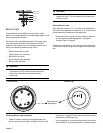
9 IMPORTANT SAFETY INSTRUCTIONS
READ AND SAVE THESE INSTRUCTIONS
English 3
Fire Safety
• Do not use aluminum foil or protective liners to line any
part of an appliance, especially the oven bottom.
Installation of these liners may result in a risk of electric
shock or fire.
• If materials inside an oven or warming drawer should
ignite, keep door closed. Turn off the appliance and
disconnect the circuit at the circuit breaker box.
• Use this appliance only for its intended use as
described in this manual. For example, never use the
appliance for warming or heating the room. Never use
the appliance for storage.
• Do not allow aluminum foil, plastic, paper or cloth to
come in contact with a hot burner or grate. Do not allow
pans to boil dry.
• If the cooktop is near a window, forced air vent, or fan,
be certain that flammable materials such as window
coverings do not blow over or near the burners or
elements. They could catch on fire.
• Always have a working smoke detector near the
kitchen.
• Never leave the cooktop unattended when in use.
Boilovers cause smoking and greasy spillovers may
ignite.
• In the event that personal clothing or hair catches fire,
drop and roll immediately to extinguish flames.
• Whenever possible, do not operate the ventilation
system during a cooktop fire. However, do not reach
through fire to turn it off.
• Have an appropriate fire extinguisher available, nearby,
highly visible and easily accessible near the oven.
• Smother flames from food fires other than grease fires
with baking soda. Never use water on cooking fires.
Burn Prevention
• DO NOT TOUCH COOKTOP ELEMENTS OR AREAS
NEAR COOKTOP ELEMENTS - Cooktop elements
may be hot even though they are dark in color. Areas
near cooktop elements may become hot enough to
cause burns. During and after use, do not touch, or let
clothing, potholders, or other flammable materials
contact cooktop elements or areas near them until they
have had sufficient time to cool. Among these areas
are the cooktop and areas facing the cooktop.
• DO NOT TOUCH HEATING ELEMENTS OR
INTERIOR SURFACES OF OVEN - Heating elements
may be hot even though they are dark in color. Interior
surfaces of an oven become hot enough to cause
burns. During and after use, do not touch, or let
clothing, potholders, or other flammable materials
contact heating elements or interior surfaces of oven
until they have had sufficient time to cool. Other
surfaces of the appliance may become hot enough to
cause burns. Among these surfaces are oven vent
openings, surfaces near these openings and oven
doors.
• Exercise caution when opening the appliance.
Standing to the side, open the door (or drawer) slowly
and slightly to let hot air and/or steam escape. Keep
your face clear of the opening and make sure there are
no children or pets near the unit. After the release of
hot air and/or steam, proceed with your cooking. Keep
doors shut unless necessary for cooking or cleaning
purposes. Do not leave open doors unattended.
• Do not heat or warm unopened food containers. Build-
up of pressure may cause the container to burst and
cause injury.
• Always place oven racks in desired location while oven
is cool. If a rack must be moved while oven is hot, do
not let potholder contact the heating elements.
• Always use dry potholders. Moist or damp potholders
on hot surfaces may result in burns from steam. Do not
let potholder touch hot heating elements. Do not use a
towel or other bulky cloth.
• Always turn hood ON when cooking at high heat or
when flambéing food (i.e. Crepes Suzette, Cherries
Jubilee, Peppercorn Beef Flambe’).
9 WARNING
TO REDUCE THE RISK OF PERSONAL INJURY
IN THE EVENT OF A GREASE FIRE, OBSERVE
THE FOLLOWING:
• SMOTHER FLAMES with a close-fitting lid,
cookie sheet, or metal tray, then turn off the
burner. EXERCISE CAUTION TO PREVENT
BURNS. If the flames do not go out immediately,
EVACUATE AND CALL THE FIRE
DEPARTMENT.
• NEVER PICK UP A FLAMING PAN—You may
be burned.
• DO NOT USE WATER, including wet rags or
towels—a violent steam explosion will result.
• Use an extinguisher ONLY if:
1) You know you have a CLASS ABC
extinguisher and you already know how to
operate it.
2) The fire is small and contained in the area
where it started.
3) The fire department is being called.
4) You can fight the fire with your back to an
exit.


















